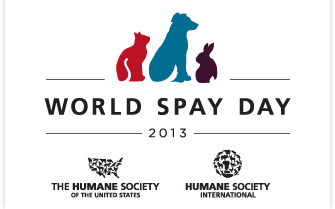Benefits of Spaying and Neutering
by ROBIN HENRY
What Is It?
Spaying and neutering are surgical procedures used to remove the reproductive organs of dogs and cats. Spaying is the removal of the uterus and ovaries of a female dog or cat. Neutering is the removal of a male dog’s or cat’s testicles. These procedures are also sometimes referred to as "sterilizing" or "fixing" pets.
How Does It Work?
Both of these procedures are performed by a veterinarian while the pet is under anesthesia, medically asleep. Spaying is generally a more involved procedure than neutering because the reproductive organs are being removed from the internal body cavity.
Although all surgical procedures carry some risks, spaying and neutering are the most common surgical procedures performed in dogs and cats, and most pets handle the surgery very well. Be sure to follow your veterinarian’s instructions regarding withholding food and water before surgery. Your pet will need to stay at the hospital anywhere from a few hours to a few days, depending on age, size, sex and condition. Also be careful to follow all recommendations for home care or aftercare, such as pain medications and post surgery appointments.
Pets can be spayed or neutered when they are as young as 8 weeks of age, and many animal shelters follow this policy before releasing pets for adoption. Otherwise, the procedure is typically recommended for dogs and cats before they reach sexual maturity (at about 5 months old).
What are the Benefits?
One of the best reasons to spay or neuter your pet is to avoid adding to the problem of pet overpopulation. Every day in the United States, thousands more puppies and kittens are born than are human babies. The result is that there are not enough homes for all these pets. The Humane Society of the United States (HSUS) estimates that between 6 and 8 million pets enter animal shelters each year. Of these pets, the HSUS believes that at least half — 3 to 4 million — are euthanized. Many of these animals are young and healthy.
Spaying and neutering also have immediate benefits for you and your pet:
- Your pet will be much less likely to get a number of serious health problems that can be life-threatening and expensive to treat, such as uterine, mammary (breast) or testicular cancer.
- Spayed and neutered pets are less likely to try to escape and roam. Roaming pets are far more likely to get into fights with other animals or to experience traumatic injuries, such as being hit by a car.
- Neutering male cats makes them less likely to mark their territory (your home) by spraying urine.
- Spaying female pets prevents them from coming into heat, that is, actively seeking a mate. Females in heat may vocalize more and may leave bloodstains on carpets or furniture. A female dog or cat in heat may also attract unwanted male canine or feline visitors to your property.
- Spayed or neutered pets are generally more even-tempered and less likely to show aggression with other animals or people.
Common Concerns
Will my pet gain weight?
You can help keep your pet from gaining unnecessary weight by not overfeeding or overindulging him with treats and by making sure she gets plenty of exercise. Regular walks (for dogs) or playtimes (for cats) can help keep your friend fit.
Isn’t it expensive?
Spaying or neutering is a one-time investment in the health of your pet. This procedure is relatively inexpensive in light of the veterinary training and medications required for it. Compare the expense of this procedure with the expense of caring for a pregnant and nursing mother, raising a litter of puppies or kittens (including the necessary vaccinations and deworming medications), and feeding puppies or kittens until they are old enough to be placed in homes. Also consider that spayed and neutered pets are less likely to roam, suffer accidents and develop certain serious diseases.
Shouldn’t my female pet have at least one litter?
Spaying female dogs and cats before they go into heat even once further reduces the chance of certain medical conditions that affect the reproductive organs. Preventing pregnancy also eliminates the possibility of your pet having complications from pregnancy and delivery. It is also very time-consuming and expensive to raise healthy offspring, and it can be very difficult to find homes for the new arrivals. Your female dog or cat will not "miss" being a mother, and if fewer puppies and kittens are born, more animals in shelters will find homes and avoid euthanasia.
This article originally appeared in PetsMatter July / August 2011, published by the American Animal Hospital Association. Copyright © 2011 AAHA.




